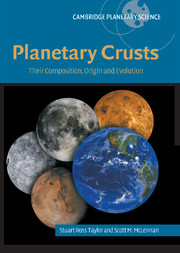Book contents
- Frontmatter
- Contents
- Preface
- Acknowledgments
- List of abbreviations
- Prologue
- 1 The planets: their formation and differentiation
- 2 A primary crust: the highland crust of the Moon
- 3 A secondary crust: the lunar maria
- 4 Mercury
- 5 Mars: early differentiation and planetary composition
- 6 Mars: crustal composition and evolution
- 7 Venus: a twin planet to Earth?
- 8 The oceanic crust of the Earth
- 9 The Hadean crust of the Earth
- 10 The Archean crust of the Earth
- 11 The Post-Archean continental crust
- 12 Composition and evolution of the continental crust
- 13 Crusts on minor bodies
- 14 Reflections: the elusive patterns of planetary crusts
- Indexes
- References
7 - Venus: a twin planet to Earth?
Published online by Cambridge University Press: 22 October 2009
- Frontmatter
- Contents
- Preface
- Acknowledgments
- List of abbreviations
- Prologue
- 1 The planets: their formation and differentiation
- 2 A primary crust: the highland crust of the Moon
- 3 A secondary crust: the lunar maria
- 4 Mercury
- 5 Mars: early differentiation and planetary composition
- 6 Mars: crustal composition and evolution
- 7 Venus: a twin planet to Earth?
- 8 The oceanic crust of the Earth
- 9 The Hadean crust of the Earth
- 10 The Archean crust of the Earth
- 11 The Post-Archean continental crust
- 12 Composition and evolution of the continental crust
- 13 Crusts on minor bodies
- 14 Reflections: the elusive patterns of planetary crusts
- Indexes
- References
Summary
It was believed up until the 1960s that Venus might be Earth-like with respect to harbouring life and writers of science fiction endowed its surface with advanced civilizations.
(Henry S. F. Cooper)The enigma of Venus
Venus has historically been regarded as a “twin planet” to the Earth as amongst the planets, it is closest to the Earth in mass, density, size and in distance from the Sun. However it has, by terrestrial standards, extraordinary crustal features and a geological history that bears little resemblance to that of the Earth. In addition, it does not possess a satellite and has a retrograde rotation with a period of 243 days.
The planet clearly warrants closer study particularly as the differences between these twin planets emphasize the problems of building crusts or discovering habitable planets in other planetary systems. So it is useful to contrast crustal development on Venus with that of its twin planet Earth, that occupy the following five chapters.
The density of Venus (5.24 g/cm3) is about 5% less than that of the Earth (5.514 g/cm3). This difference is mostly due to the slightly lower internal pressures as the planetary radius is 320 km less than that of the Earth. But the uncompressed density of both planets is very close (Earth 3.96 g/cm3; Venus 3.9 g/cm3). The similar density of Venus to the Earth and the presence of a basaltic crust on the planet are the basis for assuming a broadly similar composition and internal structure.
- Type
- Chapter
- Information
- Planetary CrustsTheir Composition, Origin and Evolution, pp. 181 - 206Publisher: Cambridge University PressPrint publication year: 2008

